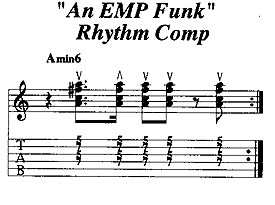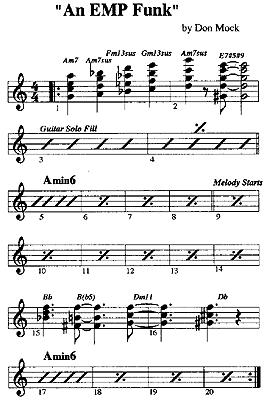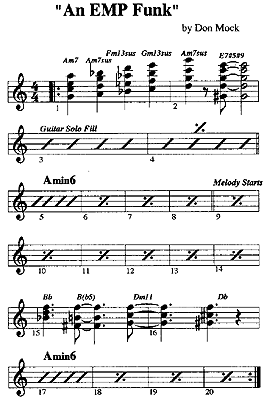Scroll through the lesson and click on notation/video/audio links to load the interactive players.
| Michael Johnson >> 70s Funk Blast >> |
|
|
Please subscribe to get full access to all lessons for only $7.95/month PLUS 1 week free trial.

Riff Interactive lessons are
LESS expensive and
MORE interactive than alternatives!
More Info
|
|
Don Mock:
Hi class
Don Mock:
Hi everyone. This is Don Mock and tonight I'd like to show you a little
fusion/funk tune which includes a rhythm part, a solo fill and some
unique chords.
Scott:
unique as in complex?
Don Mock:
By the 1980's a new sound was being used in funk. The minor 6th sound. It became very popular with the "Hip-hop" scene.
Don Mock:
Our tune, which we'll call "An EMP Funk," is rooted in the minor 6th sound
Don Mock:
Here is the guitar voicing for Am6 we'll be using for the rhythm
Am6 Chord
Don Mock:
This particular voicing, in theory, should be called Am13 because it
includes the b7th. Many minor 6th's you might play won't include the b7th
Don Mock:
Let's learn the right hand rhythm part. Here's a graphic showing the strumming along with a sound clip of me playing it

Don Mock:
If you want, you can play just the top four strings. To get the accents, only apply pressure to the frets on the played notes
Don Mock:
Now, let's check out the tune
Don Mock:
It uses our Am6 plus a few more unusual chords I'll show you in a minute
Don Mock:
Here is a sound clip of a part of the tune and a rhythm chart showing it's form

Don Mock:
I'll show you all the parts in a minute, but first let's look at the tunes form
Don Mock:
It begins with an opening interlude made up of six ascending chords. The interlude is followed by a 2 bar solo guitar riff
Mark:
Don - What do you mean by a rhythm chart? How do you read it?
Don Mock:
this is a typical rhythm chart of a tune, like you would see from fellow band members or in the studio
Don Mock:
everyone will use the same chart
Don Mock:
drummer, bass, keys, etc
punkprincess:
don...how long have u been playing?
Don Mock:
punkp I've been playing 35 years
Don Mock:
The comp pattern we just learned is now played for the first 11 bars.
This includes the 4 bar intro before the melody begins
Don Mock:
Four "punch chords" are added in bars 12-13
Don Mock:
We return to the comp for bars 14-17
Don Mock:
Then we return to the beginning interlude and play the tune again That's it
Don Mock:
Here are the six chords in the interlude
Interlude Chords
Wayne:
So the dot-bar-dot symbol is a "comp" symbol?
Don Mock:
that means repeat the previous bar
Don Mock:
don't worry about the names of the chords for now
Don Mock:
The first four chords are fairly easy. Just the top 4 strings
John:
That last chord is a killer
Don Mock:
The last chord is a favorite among jazz guitarists. It's called E7#5#9
Don Mock:
If the fingering is difficult for you, just play the top four strings by
playing a 12th fret bar with your 1st finger and the C with your 2nd
Don Mock:
Here's a short looping segment from the tune of the interlude so you can work out the chords
Skedo:
Could you show how you finger that E7#5#9
Don Mock:
It's in the tab
Don Mock:
the trick is playing 2 strings (D, G) with your 2nd finger
Don Mock:
if the loop is to fast practice with a metronome until you get it
mudfish:
Don, the chart shows a Bflat as the top note of the second chord. Did you change it later?
Don Mock:
let me check
Don Mock:
your correct mudfish
Don Mock:
the top note of the chord should be "C" and not "Bb"
mudfish:
It sounds better with the "C"
Ted:
it's hard because these are unusual chords for me
Don Mock:
these are unusual chords
Don Mock:
they're fancy substitutes for Am to E7
Don Mock:
Now here's the tab and video for the four "punch chords"
Punch Chords
Don Mock:
These chords create an "outside" effect taking the listener a bit by surprise
Don Mock:
Let's play this thing
Don Mock:
Here comes a Jam Track of the tune. Let's play it together
Don Mock:
I'll play
just the melody, and you play the Am6 rhythm part and the "interlude" and "punch" chords
Don Mock:
Play your own "solo guitar fill" if you want. I'll show you what I played a bit later
Don Mock:
Here's the chart again
Don Mock:
If you didn't learn it all, just play the parts you know. Let's do it!

Don Mock:
this file is a little larger (400k)
Ted:
why do you call them punch chords?
Don Mock:
be cause they are accented chords like horn parts
mudfish:
Don, It sounds like the keyboard is moving between an Am6 and and Am6/9. Is that the melody note or a background comp?
Don Mock:
it's the melody
John:
What the chord after the D6 part where it changes between the 2 chords. One is a D6 I think.
Don Mock:
John, I'm not sure exactly which chord you're referring to
John:
Around 17.
Don Mock:
it's a Db major triad
Don Mock:
not a D6
Don Mock:
Let me show you the first guitar fill I played
Don Mock:
I tried to come up with something that retained the "Am6" sound with some Hendrix style double stops
Don Mock:
Here's the music and tab and a sound/video clip of me playing it slow
Solo Fill
Don Mock:
The only thing that might seem tough is the position shift from the 1st bar to the 2nd (8th bar to the 5th)
Don Mock:
If you want to play your own fills and solo over this tune here's a cool scale. It's an Am6 pentatonic scale
Am6 scale
Don Mock:
This is not a regular minor pentatonic
Don Mock:
It has the 7th degree lowered to the 6th. The scale is from the key of G so you can also use a G major scale to solo with
Don Mock:
and the regular A minor pentatonic as well
Scott:
Don, earlier you said you were giving us four "punch chords", but gave us five. Is on not supposed to be there?
Don Mock:
the last one was the beginning of the rhythm part
Don Mock:
I should have left it off
Don Mock:
here's a little lick in that scale I just made
Am6 Lick
b:
whats a punch chord?
Don Mock:
it's a term for accented chords like a horn part
Don Mock:
To wrap things up for this lesson
Don Mock:
here's a short version of the entire tune
Don Mock:
Notice that it repeats directly to the melody after the 2nd interlude and solo guitar fill
Don Mock:
bye everybody
|
<< load notation from left
|
|
<< load audio from left
|
<< load audio from left
|